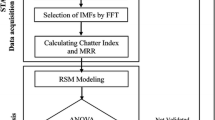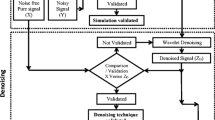Abstract
Objective of the present study is to determine an optimum range of turning parameters using merged wavelet denoising and local mean decomposition (WDLMD) technique in order to establish stable turning settings in computer numerical control (CNC) lathe. In this method, the embedded ambient noise and other disturbances in experimentally acquired chatter signals are removed using wavelet denoising (WD). Further, local mean decomposition (LMD) technique is applied on denoised signals to extract a series of product functions (PFs). Thereafter, fast Fourier transformation (FFT) of these PFs is done and then considering these FFTs, prominent PFs containing the chatter information are selected. These prominent PFs are combined to reconstruct the signal containing rich information of chatter. Finally, reconstructed signal has been explored by evaluating statistical indexes in order to extract tool chatter features and stability regimes in CNC turning. More experiments have been performed to corroborate the ascertained stability zone.
Similar content being viewed by others
References
J. Munoa, X. Beudaert, Z. Dombovari, Y. Altintas, E. Budak, C. Brecher and G. Stepan, Chatter suppression techniques in metal cutting, CIRP Annals, 65 (2016) 785–808.
I. Mancisidor, A. Pena-Sevillano, Z. Dombovari, R. Barcena and J. Munoa, Delayed feedback control for chatter suppression in turning machines, Mechatronics, 63 (2019) 102276.
A. Maamar, B. C. Bouzgarrou, V. Gagnol and R. Fathallah, Time domain stability analysis for machining processes, Advances in Acoustics and Vibration, Springer (2017) 77–88.
M. Siddhpura, A. Siddhpura and R. Paurobally, Chatter stability prediction for a flexible tool-workpiece system in a turning process, The International Journal of Advanced Manufacturing Technology, 92 (2017) 881–896.
H. Cao, Y. Yue, X. Chen and X. Zhang, Chatter detection based on synchrosqueezing transform and statistical indicators in milling process, The International Journal of Advanced Manufacturing Technology, 95 (2018) 961–972.
Y. Shrivastava and B. Singh, A comparative study of EMD and EEMD approaches for identifying chatter frequency in CNC turning, European Journal of Mechanics-A/Solids, 73 (2019) 381–393.
Y. Fu, Y. Zhang, H. Zhou, D. Li, H. Liu, H. Qiao and X. J. M. S. Wang, Timely online chatter detection in end milling process, S. Processing, 75 (2016) 668–688.
J. Lian, Z. Liu, H. Wang and X. Dong, Adaptive variational mode decomposition method for signal processing based on mode characteristic, Mechanical Systems and Signal Processing, 107 (2018) 53–77.
S. Sandoval, M. Bredin and P. L. De Leon, Using linear prediction to mitigate end effects in empirical mode decomposition, 2018 IEEE Global Conference on Signal and Information Processing (GlobalSIP), IEEE (2018) 281–285.
J. S. Smith, The local mean decomposition and its application to EEG perception data, Journal of the Royal Society Interface, 2 (2005) 443–454.
A. Nayfeh and D. J. G. S. Mook, Nonlinear Oscillations, Wiley-Interscience, New York (1979).
A. G. Y. Bonda, B. K. Nanda and S. Jonnalagadda, Vibration signature based stability studies in internal turning with a wavelet denoising preprocessor, Measurement, 154 (2020) 107520.
M. Nakagami, The m-distribution — a general formula of intensity distribution of rapid fading, Statistical Methods in Radio Wave Propagation: Proc. of a Symposium Held at the Univ. of California in 1958 (1960) 3–36.
Acknowledgments
The present work has received no funds in any manner from any organization.
Author information
Authors and Affiliations
Corresponding author
Additional information
Pankaj Gupta is a post graduate of Engineering Mechanics from Indian Institute of Technology, Delhi, India. His research interests include stability analysis, finite element analysis and structural analysis.
Rights and permissions
About this article
Cite this article
Gupta, P., Singh, B. A new ensemble approach to explore stability features in turning operation on CNC lathe. J Mech Sci Technol 35, 2819–2825 (2021). https://doi.org/10.1007/s12206-021-0605-1
Received:
Revised:
Accepted:
Published:
Issue Date:
DOI: https://doi.org/10.1007/s12206-021-0605-1




